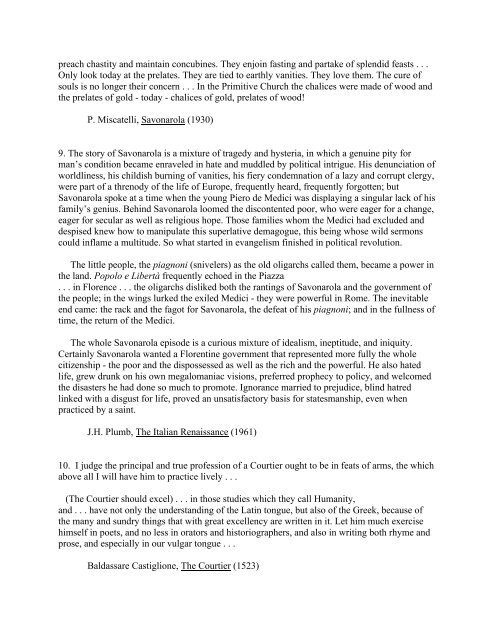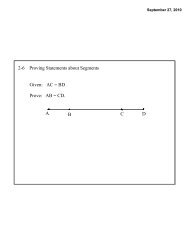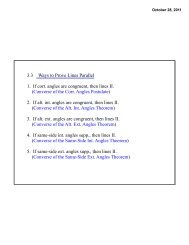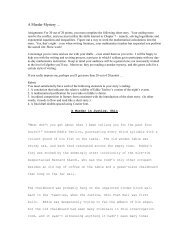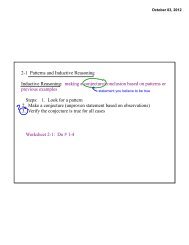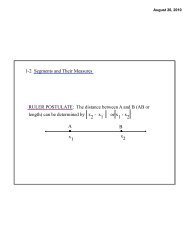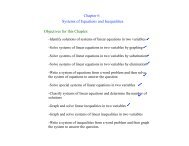DOCUMENTS: THE ITALIAN RENAISSANCE
DOCUMENTS: THE ITALIAN RENAISSANCE
DOCUMENTS: THE ITALIAN RENAISSANCE
Create successful ePaper yourself
Turn your PDF publications into a flip-book with our unique Google optimized e-Paper software.
preach chastity and maintain concubines. They enjoin fasting and partake of splendid feasts . . .<br />
Only look today at the prelates. They are tied to earthly vanities. They love them. The cure of<br />
souls is no longer their concern . . . In the Primitive Church the chalices were made of wood and<br />
the prelates of gold - today - chalices of gold, prelates of wood!<br />
P. Miscatelli, Savonarola (1930)<br />
9. The story of Savonarola is a mixture of tragedy and hysteria, in which a genuine pity for<br />
man’s condition became enraveled in hate and muddled by political intrigue. His denunciation of<br />
worldliness, his childish burning of vanities, his fiery condemnation of a lazy and corrupt clergy,<br />
were part of a threnody of the life of Europe, frequently heard, frequently forgotten; but<br />
Savonarola spoke at a time when the young Piero de Medici was displaying a singular lack of his<br />
family’s genius. Behind Savonarola loomed the discontented poor, who were eager for a change,<br />
eager for secular as well as religious hope. Those families whom the Medici had excluded and<br />
despised knew how to manipulate this superlative demagogue, this being whose wild sermons<br />
could inflame a multitude. So what started in evangelism finished in political revolution.<br />
The little people, the piagnoni (snivelers) as the old oligarchs called them, became a power in<br />
the land. Popolo e Libertà frequently echoed in the Piazza<br />
. . . in Florence . . . the oligarchs disliked both the rantings of Savonarola and the government of<br />
the people; in the wings lurked the exiled Medici - they were powerful in Rome. The inevitable<br />
end came: the rack and the fagot for Savonarola, the defeat of his piagnoni; and in the fullness of<br />
time, the return of the Medici.<br />
The whole Savonarola episode is a curious mixture of idealism, ineptitude, and iniquity.<br />
Certainly Savonarola wanted a Florentine government that represented more fully the whole<br />
citizenship - the poor and the dispossessed as well as the rich and the powerful. He also hated<br />
life, grew drunk on his own megalomaniac visions, preferred prophecy to policy, and welcomed<br />
the disasters he had done so much to promote. Ignorance married to prejudice, blind hatred<br />
linked with a disgust for life, proved an unsatisfactory basis for statesmanship, even when<br />
practiced by a saint.<br />
J.H. Plumb, The Italian Renaissance (1961)<br />
10. I judge the principal and true profession of a Courtier ought to be in feats of arms, the which<br />
above all I will have him to practice lively . . .<br />
(The Courtier should excel) . . . in those studies which they call Humanity,<br />
and . . . have not only the understanding of the Latin tongue, but also of the Greek, because of<br />
the many and sundry things that with great excellency are written in it. Let him much exercise<br />
himself in poets, and no less in orators and historiographers, and also in writing both rhyme and<br />
prose, and especially in our vulgar tongue . . .<br />
Baldassare Castiglione, The Courtier (1523)


